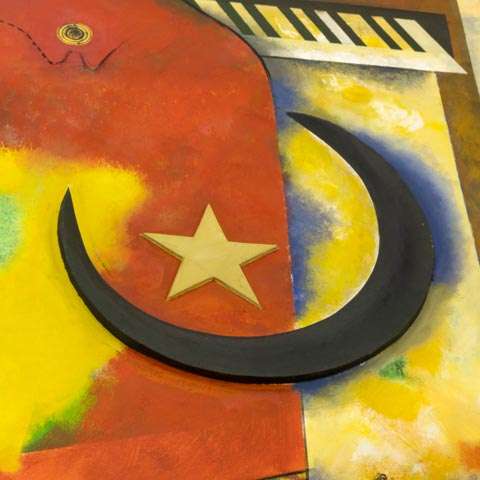
MASTERPIECES
SITNIKOV Alexander Grigorievich (1945) Dolls. 1996. Tempera on canvas, collage. 128 × 108
Spectacular, more than a meter, bright canvas. And a bold plot. Piano keys, flutes, immodest performers, stars and a crescent moon. Music and primal instincts are among the main themes in the work of Alexander Sitnikov. As well as mysticism, myths, historical legends. And in this work, everything is not easy. The star and the crescent moon are associated with Muslim symbols. But in fact, this imagery has been known since the time of the Sumerian civilization, where the month is the sign of the god Sina, and the star is the sign of the goddess Ishtar. But that is not all. Noticed the hammer and sickle in the center? One way or another — in any case, the interpretation of “Dolls” will be an exciting experience for the new owner.
Recall that Alexander Sitnikov is a master of naive and ironic lyricism. His paintings are presented in the collections of the Tretyakov Gallery, the Russian Museum, and the Moscow Museum of Modern Art. Sitnikov was one of the few participants in the legendary Sotheby's 1988 auction in Moscow. At the world's leading auctions, his paintings have repeatedly hit the bar of $ 50,000.
WORLDS OF VLADIMIR NEMUKHIN
NEMUKHIN Vladimir Nikolaevich (1925–2016) Abroad. 1990. Paper, pencil, color pencils, acrylic. 50 × 50
NEMUKHIN Vladimir Nikolaevich (1925–2016) The movement of forms in space. 1996. Sculpture. Tinted tree. 41 × 9 × 8.5
Two works by one of the main artists of post-war unofficial art, a member of the Lianozovo group and a participant in the Bulldozer exhibition. Things are very unusual. Rare plots. Sculpture is not a dedication to a famous artist, but an abstraction that symbolizes the movement of forms in space. That's what it's called. Well, in “Abroad” authorship of Nemukhin is given out only by two cards. The rest is almost politics. Fronde. A reminder of the curtain, freedom and non-freedom.
ZVEREV Anatoly Timofeevich (1931–1986) Portrait of the artist Vladimir Nemukhin. 1983. Ink on paper. 50 × 64
This drawing got to “Worlds of Nemukhin” for the company. This is a portrait by a friend of Vladimir Nemukhin, the brilliant Anatoly Zverev. The drawing was in Nemukhin's collection for two decades. The thing will be of interest to connoisseurs and is best suited for an already formed collection.
INTERESTING STORY
ZUBAREV Vladislav Konstantinovich (1937–2013) Flower. Gethsemane night. 2001. Oil on canvas. 100 × 64
The thing is good, and what a name! In fact, Zubarev often gave his abstract expressionist works clear concrete “figurative” names. But not all of them have survived to this day. Out of ignorance, for the sake of simplicity, we call them abstract compositions. But here art lovers were lucky. On the back, Zubarev's hand says “Flower. Gethsemane night”. This is an obvious reference to an important event in New Testament history. Gethsemane is the very night from Thursday to Friday when Jesus Christ was captured by Roman soldiers and the guard of the high priest. It happened in the Garden of Gethsemane — in a grove not far from Jerusalem, where, anticipating difficult trials, Christ hid with his disciples after the Last Supper. That night Jesus said goodbye to the worldly life, offered up prayers. The ominous kiss of Judas and the prayer for the cup — “let this cup pass from me” — all these are events of the Gethsemane night. Why a cup? According to one of the versions, those sentenced to a cruel death were given a cup of poison or a psychotropic drug before execution to relieve suffering. But everyone hoped that this time the cup would be carried past him. Why a flower? This is most likely already Zubarev’s metaphor. A symbol of hope, a symbol of rebirth, a symbol of an inextinguishable life. Gethsemane garden exists to this day. Though, today it is rather a small square.
Vladislav Zubarev is one of the best students of Ely Bielutin, he studied in his studio “New Reality”. And then Zubarev founded his own studio, “Temporal Reality”.
GINTOVT Alexey Yurievich (1965) Pre-dawn III. 2020. Canvas, author's technique. 100 × 100
In our opinion, this is one of the best subjects in the work of Alexei Gintovt. From one of the brightest contemporary artists in Russia. Gintovt is a statist, statesman, Eurasian, the keeper of the dream of the revival of imperial greatness. For this, many condemn and criticize him, falling to the level of bullying. But he doesn’t care, as befits a true convinced artist. A flurry of condemnation is not a reason to change beliefs and stray from the path. His style is called “new empire”, “Russian classicism”, “imperial avant-garde”. Gintovt's signature technique is conciseness and concreteness. His paintings are not full of details — redundancy harms the concept. There is a clear metaphor. There are images to express it. There is a template. And there are palms that will paint. So this time: an eagle that has set its claws on the planet-ball, and another eagle-observer soars in the sky. Pre-dawn? Why? Dream, foresight, prediction? Who knows. The artist gave all the tips, and then the viewer's work begins.
- Log in to post comments










